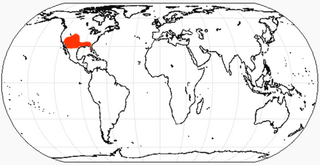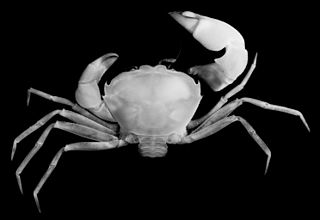| Metzgeriites Temporal range: | |
|---|---|
| Scientific classification | |
| Kingdom: | Plantae |
| Division: | Marchantiophyta |
| Class: | Jungermanniopsida |
| Order: | Metzgeriales |
| Genus: | † Metzgeriites Steere [1947] |
Metzgeriites is a genus of fossil liverwort.
| Metzgeriites Temporal range: | |
|---|---|
| Scientific classification | |
| Kingdom: | Plantae |
| Division: | Marchantiophyta |
| Class: | Jungermanniopsida |
| Order: | Metzgeriales |
| Genus: | † Metzgeriites Steere [1947] |
Metzgeriites is a genus of fossil liverwort.

The Xyelidae are a comparatively species-poor family of sawflies, comprising about 80 extant species in five genera worldwide, and is the only family in the superfamily Xyeloidea. The fossil record of the family is extensive, comprising more than 120 species and including the oldest fossil Hymenoptera species dating back to the Triassic, between 245 and 208 million years ago. Xyelidae are to be regarded as living fossils since they represent one of the oldest lineages of insects and include still extant forms.
The Day of the Dinosaur is a science book by L. Sprague de Camp and Catherine Crook de Camp, illustrated with plates. It was first published in hardcover by Doubleday in 1968, and in paperback by Curtis Books in 1970 or 1971. A second hardcover edition was issued by Bonanza Books in 1985. The first chapter was reprinted as "One Day in the Cretaceous" in the de Camps's collection Footprints on Sand.
Syringogaster is a genus of small ant-mimicking flies with a petiolate abdomen, a long prothorax, a swollen and spiny hind femur, and reduced head size and large eyes. There are 20 described extant species and two species known from Miocene amber from the Dominican Republic. It is the only genus in the family Syringogastridae.
Coriops is a genus of prehistoric bony fish. Its fossils are found in Campanian, Maastrichtian, and possibly Paleocene age deposits. This chronological distribution means that the genus may have survived the Cretaceous–Paleogene extinction event that killed the dinosaurs.
Mammalian Species is a peer-reviewed scientific journal published by Oxford University Press on behalf of the American Society of Mammalogists. The journal publishes accounts of 12–35 mammal species yearly. The articles summarize the current literature about each mammal and its systematics, genetics, fossil history, distribution, anatomy, physiology, behavior, ecology, and conservation is described. The journal was established in 1969. The current editor-in-chief is Meredith J. Hamilton.

Carpocyon is an extinct genus of the Borophaginae subfamily of canids native to North America. It lived from the Middle to the Late Miocene, 13.6 to 5.3 Ma Mya, existing for approximately 16.5 million years. The four species in the genus varied in size, with the largest being about the size of a wolf; all had relatively small teeth, suggesting a diet that was more omnivorous than that of other contemporary borophagines.

Phlyctaenius is an extinct genus of placoderm fish, which lived during the Devonian period of New Brunswick, Canada. It was named by Traquair (1890) as a replacement for Phlyctaenium Zittel (1879), which was preoccupied.

Elegantaspis reticornis is an arthrodire placoderm fish, which lived during the Early Devonian period in Spitsbergen, Norway.

Cartieraspis is an extinct genus of Phlyctaeniid placoderm fish which lived during the Middle Devonian period in North America. Whether or not it is morphologically different enough from its close relative and contemporary Phlyctaenius to be considered generically distinct is dubious.
Blinasaurus is a name of an extinct genus of prehistoric brachyopid found in Triassic geological formations of Australia. The type species is Platyceps wilkinsonii Stephens, 1887. The genus was established by John W. Cosgriff in 1969 to incorporate the type, discovered in New South Wales, and the author's new fossil species, Blinasaurus henwoodi, describing type material found in Blina Shale in the Kimberley region of northwest Australia.
Casierius is an extinct genus of prehistoric bony fish that lived during the Albian stage of the Early Cretaceous epoch. It is one of the oldest eels. The fossils of this animal were found in Glen Rose Formation near, Hood County, Texas.
Dwykia is an extinct genus of prehistoric bony fish that lived during the Carboniferous period in what is now South Africa. Fossils were recovered from the Upper Witteberg Series.
Willomorichthys is an extinct genus of prehistoric bony fish that lived during the Carboniferous period in what is now South Africa. Fossils were recovered from the Upper Witteberg Series.
Sundayichthys is an extinct genus of prehistoric bony fish that lived during the Carboniferous period in what is now South Africa. Fossils were recovered from the Upper Witteberg Series.

Trichodactylidae is a family of crabs, in its own superfamily, Trichodactyloidea. They are all freshwater animals from Central and South America, including some offshore islands, such as Ilhabela, São Paulo. Only one of the 50 species is known from the fossil record, Sylviocarcinus piriformis from the Miocene of Colombia. The family contains 15 genera in two subfamilies:

Pseudozioidea is a superfamily of crabs, formerly treated in the Eriphioidea, Carpilioidea, Xanthoidea, Pilumnoidea and Goneplacoidea. A number of fossils from the Eocene onwards are known from the family Pseudoziidae. Eleven genera are recognised in three families:

The Witteberg or Witteberge is a South African mountain range just off the south-west corner of Lesotho. The range, which rises to 2408 metres, stretches for about 60 km (37 mi) from Lundin's Neck in the east to Lady Grey in the west. The range lends its name to the Witteberg Series, the uppermost fossiliferous sequence of the Cape System of sedimentary rocks in South Africa.
Hertzina is an extinct genus of conodonts in the family Furnishinidae. Fossils can be found in the Wheeler Shale Cambrian fossil locality in Utah, United States.
Heightingtonaspis is an extinct genus of primitive arthrodire placoderm fish from the Devonian period in Great Britain, and currently contains three species.

Bauruemys is an extinct genus of turtles in the family Podocnemididae.